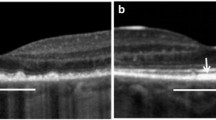Abstract
Background
Vogt-Koyanagi-Harada (VKH) disease presents with anterior segment inflammation, choroiditis and exudative retinal detachment. Following resolution of the inflammation, VKH patients have been noted to complain of visual disturbances despite good visual acuity. We therefore investigated the visual function deficits of convalescent VKH patients.
Methods
A cross-sectional observational nonrandomized controlled study of convalescent VKH patients from the Uveitis Service of the Singapore National Eye Centre, and normal subjects was performed. The best-corrected visual acuities (BCVA) and multifocal electroretinograms (mfERGs) of VKH patients with and without peripapillary atrophy (PPA) were compared with those of the normal eyes. The mfERG results were subdivided into those obtained from the peripapillary area and those from the rest of the macular.
Results
Eleven VKH eyes with large PPA to disc ratios (PPA/D ratio >2), 15 VKH eyes with PPA/D ratios<1 and 6 normal eyes were included in the study. Five eyes (54.5%) of VKH patients with PPA/D>2 had a BCVA of less than 20/40. All the other eyes had 20/20 vision. Nine of the 11 VKH eyes with PPA/D>2 also had large areas of chorioretinal atrophy.
The mfERG responses of VKH eyes with PPA/D ratio >2 were markedly reduced in amplitude (p<0.001) and delayed in implicit time (p<0.001) throughout the entire macular area. VKH patients with PPA/D ratio<1 had significantly reduced mfERG amplitudes throughout the entire macular area, as well as delayed implicit times at the peripapillary region (p=0.026). Sub-division of VKH eyes with PPA/D<1 into eyes with no PPA and eyes with a small PPA, showed that both groups had a similar reduction in response amplitude over the entire macular region. However, the implicit time was significantly delayed in eyes with small PPA when compared to those without PPA (p<0.03).
Conclusions
VKH patients with large PPA have clinically significant visual dysfunction. VKH patients without PPA also have subclinical retinal dysfunction. The mfERG may be a useful adjunct in the management of VKH by detecting early retinal damage.


Similar content being viewed by others
References
Beniz J, Forster DJ, Lean JS, Smith RE, Rao NA (1991) Variation in clinical features of the Vogt-Koyanagi-Harada syndrome. Retina 11:275–280
Bouchenaki N, Herbort CP (2001) The contribution of indocyanine green angiography to the appraisal and management of Vogt-Koyanagi-Harada disease. Ophthalmology 108:54–64
Chee SP, Yeo YSI (1998) Peripapillary atrophy in Vogt Koyanagi Harada syndrome. In: Ohno S, Aoki K, Usui M, Uchi E (eds) Uveitis today-.Excerpta medica International Congress Series 1158. Elsevier, Amsterdam, pp 181–184
Goto H, Rao NA (1990) Sympathetic ophthalmia and Vogt-Koyanagi-Harada syndrome. Int Ophthalmol Clin 30:279–285
Inomato J, Rao NA (2001) Depigmented atrophic lesions in sunset glow fundi of Vogt-Koyanagi-Harada disease. Am J Ophthalmol 131:607–614
Keino H, Goto H, Usui M (2002) Sunset glow fundus in Vogt-Koyanagi-Harada disease with or without chronic ocular inflammation. Graefe Arch Clin Exp Ophthalmol 240:878–882
Kondo N, Kondo M, Miyake Y (2001) Acute idiopathic blind spot enlargement syndrome: prolonged retinal dysfunction revealed by multifocal electroretinogram technique. Am J Ophthalmol 132:126–128
Mimura Y (1991) New criteria for Vogt-Koyanagi-Harada disease without sunset glow fundus. Nihon Ganka Kiyo Folia Ophthalmol Jpn 42:715–718
Moorthy RS, Inomata H, Rao NA (1995) Vogt-Koyanagi-Harada syndrome. Surv Ophthalmol 39:265–292
Nussenblatt RB (1988) Clinical studies of Vogt-Koyanagi-Harada’s disease at the National Eye Institute, NIH, USA. Jpn J Ophthalmol 32:330–333
Ohno S, Minakawa R, Matsuda H (1988) Clinical studies of Vogt-Koyanagi-Harada’s disease. Jpn J Ophthalmol 32:334–343
Okada A, Mizusawa T, Sakai J, Usui M (1998) Videofundoscopy and videoangiography using scanning laser ophthalmoscope in Vogt-Koyanagi-Harada syndrome. Br J Ophthalmol 82:1175–1181
Perry HD, Font RL (1977) Clinical and histopathologic observation in severe Vogt-Koyanagi-Harada syndrome. Am J Ophthalmol 83:242–254
Read RW, Rechodouni A, Butani N, Johnston R, LaBree LD, Smith RE, Rao NA (2001) Complications and prognostic factors in Vogt-Koyanagi-Harada disease. Am J Ophthalmol 131:599–606
Sasamoto Y, Ohno S, Matsuda H (1990) Studies on corticosteroid therapy in Vogt-Koyanagi Harada disease. Ophthalmologica 201:162–167
Sonoda S, Nakao K, Ohba N (1999) Extensive chorioretinal atrophy in Vogt-Koyanagi-Harada disease. Jpn J Ophthalmol 43:113–119
Sutter EE, Tran D (1992) The field topography of ERG components in man. The photopic luminance response. Vis Res 32:433–446
Suzuki S (1999) Quantitative evaluation of “sunset-glow” fundus in Vogt-Koyanagi-Harada disease. Jpn J Ophthalmol 43:327–333
Synder DA, Tessler HH (1980) Vogt-Koyanagi-Harada syndrome. Am J Ophthalmol 90:69–75
Yoshida H, Tada R, Nakagawa Y, Ohji M, Sasabe T, Haruta Y, Yuasa T (1988) Course of uveitis and visual function in retarded cases of Harada’s disease. Acta Soc Ophthalmol Jpn 92:726–730
Acknowledgements
This study was supported by a grant from the Singapore Eye Research Institute.
Author information
Authors and Affiliations
Corresponding author
Additional information
The authors have no financial relationship with the Singapore Eye Research Institute that has sponsored the research, and have full control of all primary data and agree to allow Graefes Archives for Clinical and Experimental Ophthalmology to review our data if requested.
Rights and permissions
About this article
Cite this article
Chee, SP., Luu, C.D., Cheng, CL. et al. Visual function in Vogt-Koyanagi-Harada patients. Graefe's Arch Clin Exp Ophthalmol 243, 785–790 (2005). https://doi.org/10.1007/s00417-005-1156-3
Received:
Accepted:
Published:
Issue Date:
DOI: https://doi.org/10.1007/s00417-005-1156-3




